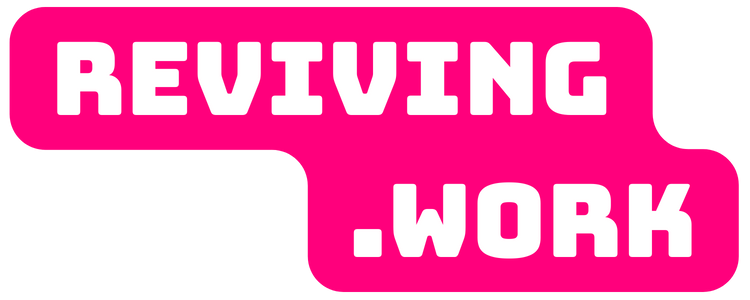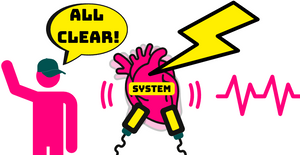
The Working Dead: how to revive our work life and prevent the systematic creation of zombie workers
Our view of humanity is often distorted. Our narrow perspective, or more accurately our information and experience bubble, nourishes a widespread negativity bias. This bias inevitably shapes our image of humanity, especially at work where we most frequently interact with others. Our recurring encounters with frustrated and disengaged people who just aren’t passionate about their work anymore highly influence us. These Zombie Employees are usually slow to react, often spread negativity, and eventually will become bad for business. We quickly notice that these people do as little as possible and just as much as required to not face any consequences. They are the Working Dead.
ZOMBIES ARE EXPENSIVE
Many professional organizations have involuntarily but systematically fostered this kind of behavior for many decades. It is often caused by dangerous assumptions of their carelessly indoctrinated group of managers. Or more precisely: the broken and outdated system that is encouraging this way of thinking.
We live in a world where complex market dynamics are ruthlessly separating the winners from the losers. Companies cannot afford to tolerate the working dead if they want to survive. Organizations need to learn how to leverage every single one of their employees to his or her fullest potential. Only then will they outperform organizations that are content with their zombie employees. Gallup estimates the financial impact of zombie employees to be around $550 billion for the USA alone. This economical perspective is not even taking into account the obvious ethical point of view in which people are suffering in such organizations.
THE SELF-FULFILLING PROPHECY
There are several well-known reasons explaining the origin of this misery. We see most people not for what they are but for how they behave in their current context and environment. This is especially true at work. Our resulting beliefs are constantly confirmed by working in organizations that still apply Frederick Taylor’s social technology scientific management. We form biased observations, based on our local environment. Eventually, we believe that many people can be described with the following characteristics that Douglas McGregor called Theory X in his bestseller The Human Side of Enterprise:
- People don’t want to work and try everything to avoid it. They are lazy by nature.
- People must be forced or coerced to perform. This usually happens through a motivator like money or fear of eventually losing their job.
- People shy away from any responsibility.
- People have very little creativity, except when trying to avoid work.
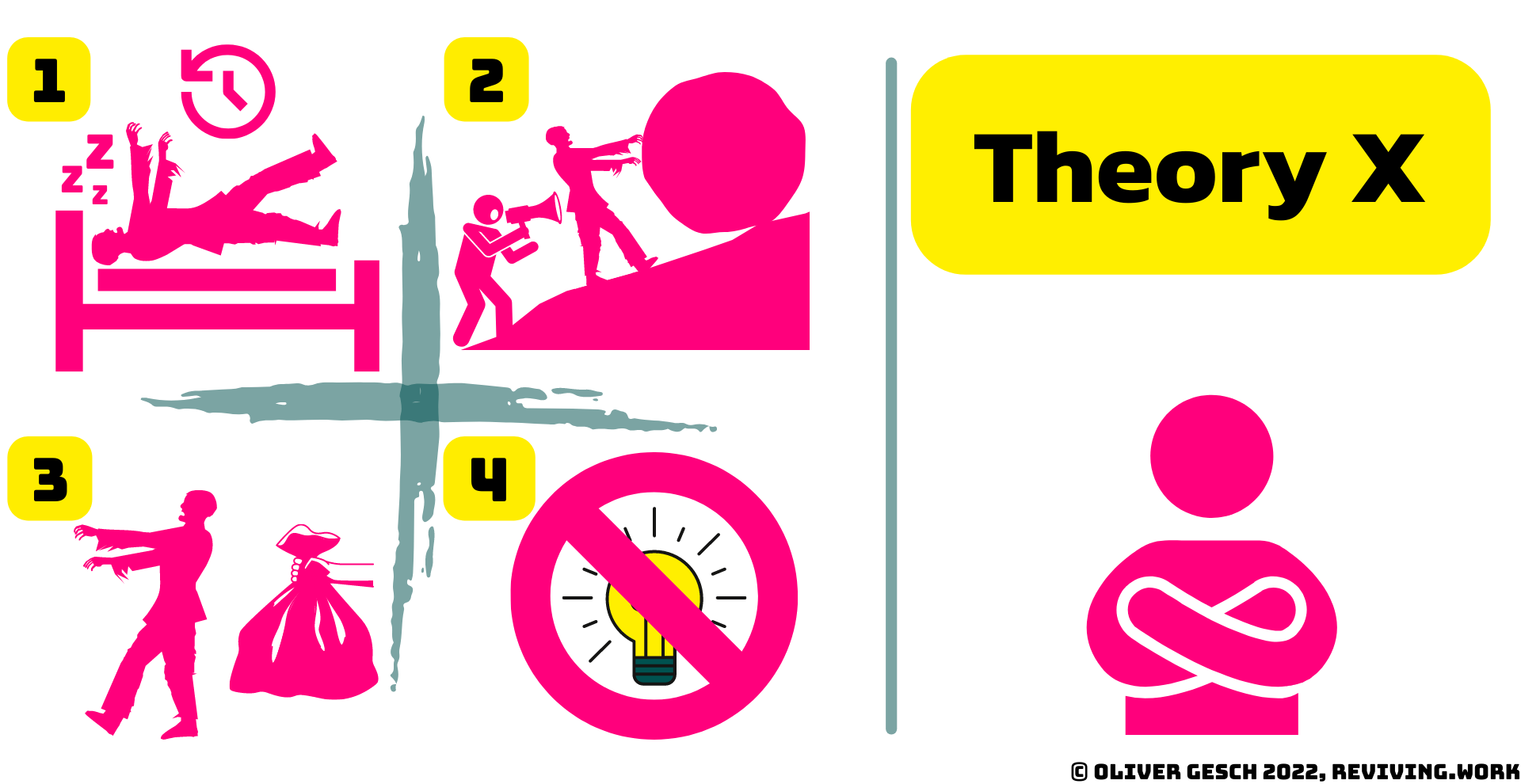
This predominant view of humanity tremendously influences our way of behaving, talking, and acting around our colleagues and peers. We treat people based on this view expecting that they will confirm our beliefs. This is also called confirmation bias. We don’t trust them with high-profile work and only let them do meaningless tasks with very little risk of failure. We give them detailed instructions, specific down to the very last detail. We want them to follow the process, with no exceptions. We don’t value their input and we don’t ask them about their opinion.
Theory X downward spiral
People recognize how they are treated. They start to adjust their very being to these external expectations. These wrongly misjudged people will now start to question their performance and value to the organization. They understand that their coworkers or supervisors do have that deeply rooted prejudice, that Theory X view of them. Ultimately they surrender their true selves to that flawed image. They stop caring about their work and they will stop accepting responsibility. They will only do their work based on positive or negative external incentives.
Their team or supervisor does not see them as valuable additions to aid their cause. As a result, they will receive fewer and fewer meaningful or interesting tasks at work. Instead of growing with their challenges, their motivation and skill will deteriorate, slowly but surely. They realized that other people will think for them. They are only supposed to act based on other people’s thinking. At some point, they just give up. This circle of cause and effect is also called the Andorra phenomenon. People with a Theory X view of humanity consider these observations about people as proof of their beliefs. They even feel vindicated. The vicious cycle of having a Theory X view starts again.
UNREFLECTED REPERCURSSIONS
Most people rarely acknowledge the implications of their Theory X view of humanity. For them, it has become the norm that people cannot be trusted to work autonomously and make decisions on their own. But what are the consequences? According to Theory X employees are lazy and try to avoid work. They have to be coerced or almost bribed to show up and do their work. At work, they have to follow very detailed instructions and rules. These meticulously crafted plans by people higher up in the organization are supposed to ensure that they don’t ruin the envisioned business results.
Employees also need to be controlled, steered, monitored, and surveilled to make sure they do exactly what they are told. In addition to the ethical aspect related to this downward spiral of demotivated people caused by Theory X, there is also the economical aspect. Supervisors and other positions aimed at controlling, steering, and monitoring employees are usually fighting windmills.
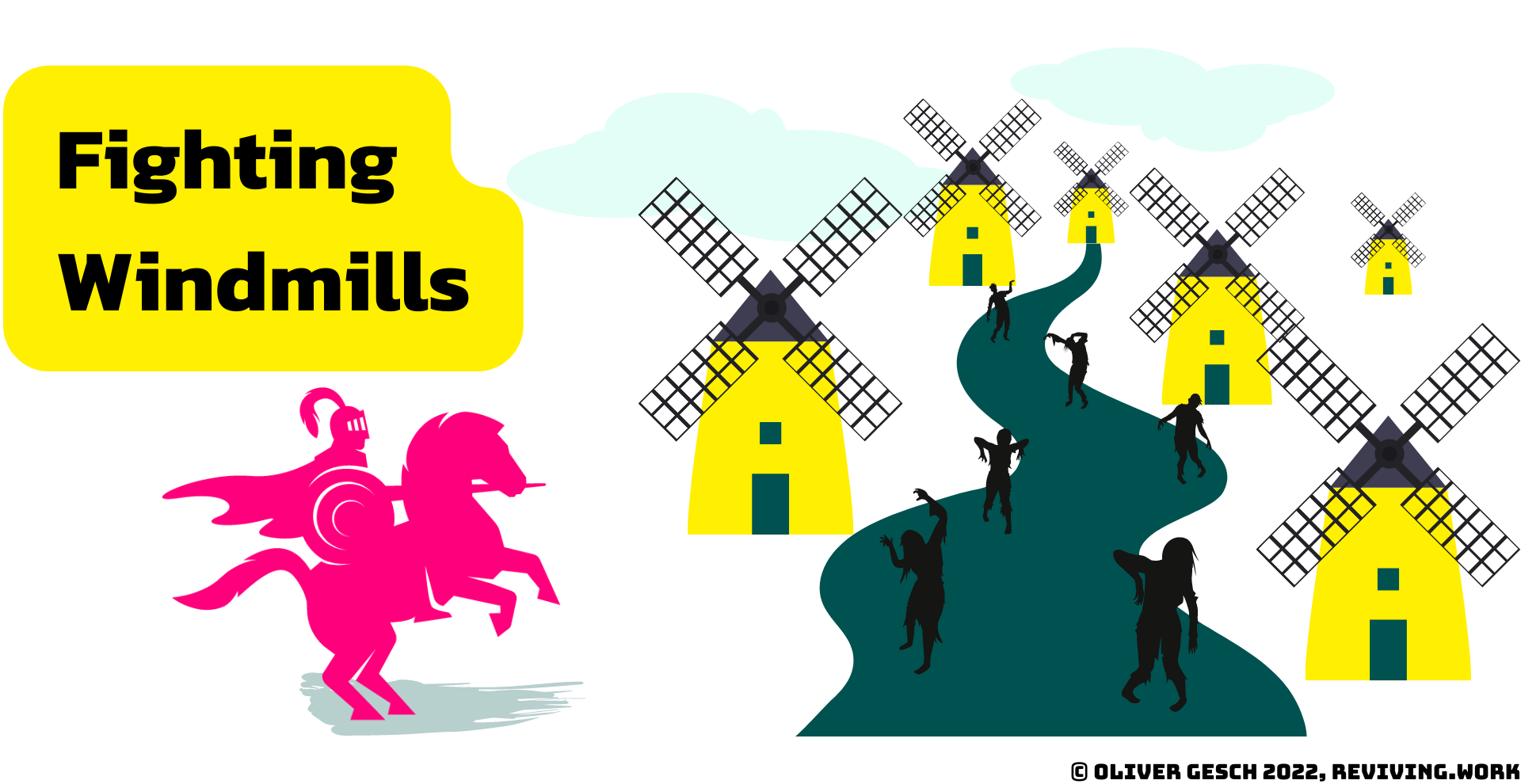
A futile effort
This middle management spends the majority of their time making sure a certain number of other people are doing their job to the minimum degree that has been agreed to in contracts, company rules, and periodic goal-setting. In organizations that are set up in a traditional, hierarchical, and centralized way this is very visible. These companies usually have a high ratio of middle management positions that are fully occupied with the following activities:
- Controlling, commanding, and correcting people, because they can’t be trusted to learn by themselves.
- Inventing new (process) improvement opportunities, because those can only become from trusted people in the leadership circle.
- Planning the future, because all that controlling, commanding, and steering people needs to be based on predictions. This is happening regardless of how inaccurate or fragile those predictions might be.
Planning and steering have no effect
Employees who are treated this way by their organization rarely adhere to these invasive measures. They either don’t care anymore or they fear that their share of the work, which no one seems to value anyway, increases. More often than not the directions from the leadership circle reach them way too late at their level of the organization. Situations often change between phases of planning, agreement, and execution, since reality does not follow yearly or quarterly planning activities.
Therefore the middle manager has rather limited influence on the success of an organization. However, the increased cost of his position compared to someone on the operative level of work is still much higher.
Economically, this approach to setting up an organization is very unfavorable.
THE HUMAN SIDE OF ENTERPRISE
So is there no escape from the inevitable zombie worker organization? Fear not because Douglas McGregor conceived a second view of humanity in The Human Side of Enterprise called Theory Y. This mental model inverts the statements about people based on Theory X:
- Although people have to work to make a living, under the right circumstances people enjoy working.
- People are at their core intrinsically motivated and can lead themselves.
- People take over responsibility voluntarily.
- Everyone is creative.
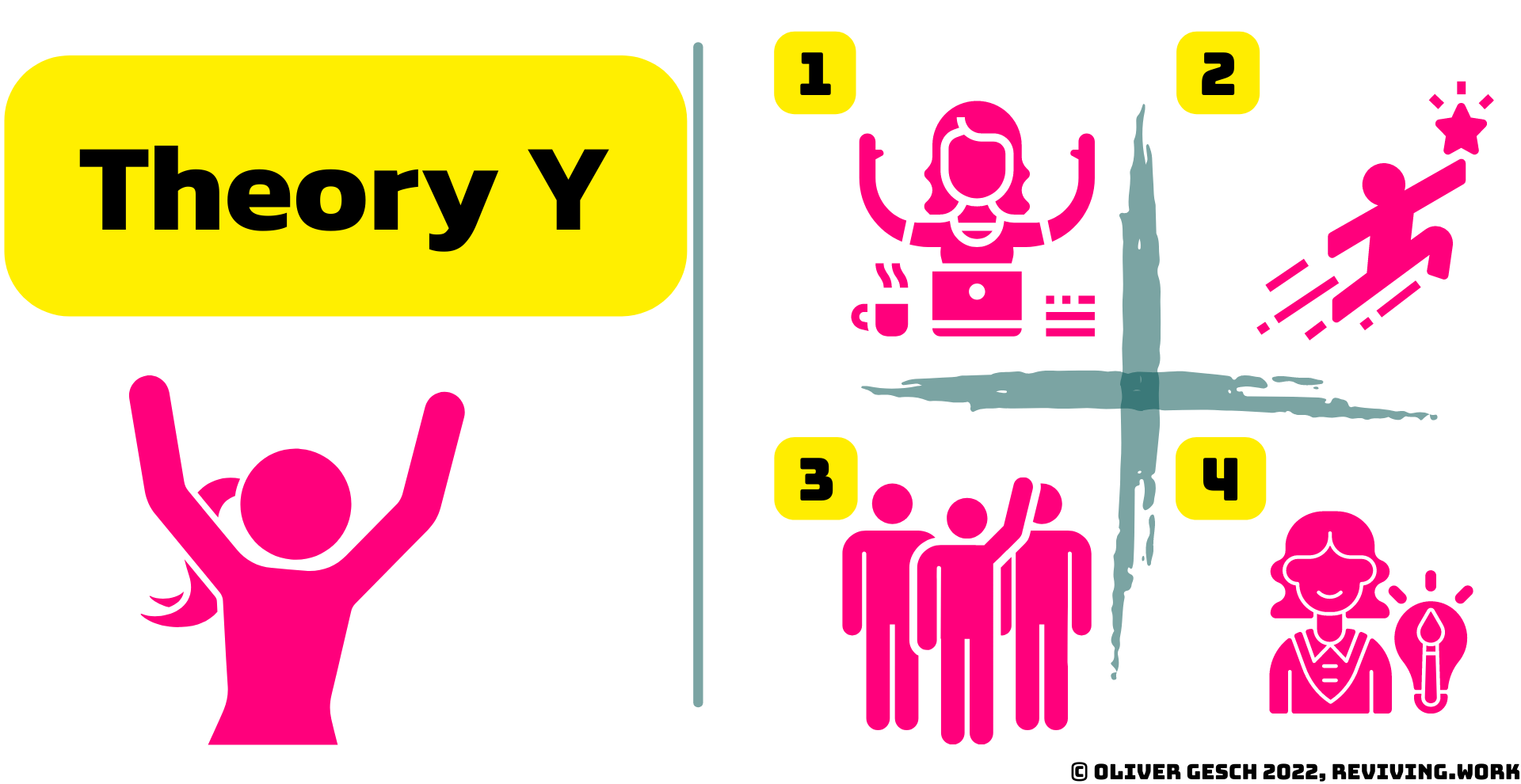
Douglas McGregor was often misunderstood in his model of humanity. Many people who read his work superficially spread the misconception that there is a group of people that inherently proves the validity of Theory X. However he never actually stated this explicitly. There is no scientific evidence that such a group of people does exist.
Money is not the incentive we think it is
Most people think that anyone with the luxury of financial freedom would quit his or her job and never work again. But is that really because these people don’t want to work at all? Or is it because their current work does not allow them to fulfill their higher level of needs? Just think about people that will never have to work again in their lifetime due to their fortune: Bill Gates, Jeff Bezos, Elon Musk, etc. These billionaires work longer and harder than most regular 9-5 employees although they could just let go and procrastinate all day.
Money and making a living can’t be their reason to go to work every day, which means money is not the incentive everybody is trying to make it.
UNDERSTANDING MOTIVATION
But what exactly motivates us to do anything at all in the first place? What makes us passionate about something, and what naturally sharpens our focus as human beings? Abraham Maslow answered that question in his concept of a universally applicable hierarchy of needs, first mentioned in A Theory of Human Motivation in 1943. Although numerous studies are debating whether there is a certain order of priority when it comes to Maslow’s understanding of human needs, at a minimum these needs have an undeniable influence on human motivation:
- Physiological needs: breathing, drinking, eating, sleeping.
- Safety needs: protection against danger, threat, unemployment.
- Social needs: e. g. friendship, family, acceptance, belonging.
- Egocentric needs: e.g. self-confidence, independence, achievements, competence, knowledge.
- Self-fulfillment needs: self-development, being creative, morality.
Maslow argued that we are not interested in satisfying our higher-level needs like egocentrism and self-fulfillment if our lower-level needs are not sufficiently covered yet. He believed that people suffering from unfulfilled physiological needs like hunger or lack of safety (imagine a war zone or becoming unemployed) were much less likely to focus on fulfilling their higher-level needs.
Motivators are fluent
More recent research shows that there is often a mix of motivators for people trying to satisfy different levels of needs all at once. Science considers human needs more fluid now and Maslow himself argued for this fluidity late in his career. McGregor later argued that once our lower-level needs are sufficiently addressed we are not motivated by them anymore. Only the threat of potentially not being able to fulfill these lower-level needs might lead to renewed but short-lived motivation again. Regardless of the order of priority, there is a consensus that motivation is influenced by all five levels of needs. We self-motivate and deliver betters results if our basic needs are covered and our higher-level needs can become our main focus.
EXPOSING THE THEORY X FALLACY
The inspiring speaker, consultant, and author Niels Pfläging conducted a very interesting experiment during one of his talks during the German Innovation Day 2017. He asked the audience to fill out two paper cards answering the following two questions:
- Yellow: What kind of human am I? Theory X or Theory Y?
- Red: What is the percentage of Theory X people in your (global) organization?
He then asks the audience to raise all the yellow cards which show Theory X, meaning someone who considers himself or herself a person motivated by the concepts of Theory X. Of course only very few people raise their cards. He then asks the audience to raise the red card if it shows 0%. 13 people are raising their cards.
At this point, you will probably start to ask yourself: this will not add up. If there are zero Theory X people in the audience but almost everyone in the audience feels like there are more than 0% of Theory X people in their respective organization, we immediately recognize the fallacy: Theory X people only live in our heads. It’s a matter of perception, context, and personal bias.
This is also the conclusion of Niels’ experiment: There was never any empirical or anecdotal evidence that there are Theory X people by nature. And this is probably the most important insight I would like you to take away from reading this article.
IMAGINE A WORLD WITHOUT THE WORKING DEAD
So how do we escape this never-ending circle, this spiral of Theory X prejudice, that happens just in our heads? How do we enable high-performing organizations with high-performing employees?
The first step to lasting change always starts with self-awareness: am I part of the problem or part of the solution? This means working hard on ourselves to open our minds and recall that the world only contains Theory Y people. Even right now there are only Theory Y people hidden behind Theory X’s appearance and behavior. Their environment and their context fostered this metaphorical wall. Everyone that we know, everyone that we meet or interact with, is by definition a Theory Y person. Once we can accept that as a fact we will start to treat people differently.
Relate, repeat, reframe
This change won’t happen overnight. A lot of the time we will still fall short of overcoming our Theory X bias. We have to acknowledge and counter the urge to succumb to this common misconception again and again. We need to practice our self-awareness and subsequently restrain our unconscious associations. Over time this will become easier and easier until it is second nature. Finding like-minded people and reflecting on our learnings and insights will help to create lasting change in us and our peers.
HOW TO REVIVE THE WORKING DEAD
Whenever we question the behavior of another human being we need to make the connection to Maslow’s hierarchy: which need is the other person trying to fulfill right now? This is especially important when trying to outperform competitors in a corporate organization: most take care of the basic physiological needs of their employees. This means paying them, hopefully fairly, making sure they have job security, and consequently allowing them to focus on the other more sophisticated needs of Maslow’s hierarchy. Don’t try to create performance by threatening to withdraw some of their basic needs. Instead, make sure you also cater to your employees’ higher level of needs:
- Stop any kind of bonus system and instead introduce company profit participation.
- Respect, trust and actively listen to your employees. Breaking out of the circle of a Theory X view requires an advance in trust between employee and employer.
- Enable your employees to form circles of learning to gain insights at work based on unconditional sharing and let them rekindle their natural curiosity.
- Provide ample opportunities for people to voluntarily take over responsibility, tackle challenges and invite them to take matters into their own hands.
- Always assume positive intent and act accordingly when contemplating someone’s actions. Just like laughter, our behavior, our beliefs, and our view of humanity will spread and infect others. We need to talk about it and ask open-ended questions to make other people doubt their prejudices. We need to let them come to the right conclusion on their terms.
WHAT QUESTIONS DO I ASK PEOPLE WHO DON'T AGREE?
You will always meet people who are unwilling to reflect on what they hear from you, and who will not question their own beliefs instinctively. They will require repeated personal interaction, and invitations to think and re-think what was said. You cannot convince anyone of anything, there can only be realization based on personal insight. The following questions might help you to influence a discussion in the desired direction. They are a starting point to plant the seed of doubt in others:
- Are humans born with the assumed characteristics of Theory X or Theory Y or is the corresponding behavior of individuals developed due to context and personal environment?
- What does it say about us as a society if we predominantly assume Theory X is true?
- What are the implications and consequences of assuming Theory X is true and widely spread, especially at work?
- What is the most promising way to break out of a downward spiral of negativity?
- How do we spark change if not by changing ourselves first?
SUMMARY
Our surroundings influence us tremendously. Breaking that environmental bias and applying the intrinsic motivational concept of Theory Y by McGregor is our responsibility. It requires repetition and constant reflection to not fall back into vicious and inhuman cycles of misjudging human nature. Always remember that there is no evidence for Theory X. Ask questions that raise self-doubt in people and find like-minded people to connect with and support each other. Lasting change is a concept of frequent, well-thought-through interventions supported by group dynamics. Start today and let me know what you learned, I am excited to hear you talk about your experiences!
ONE MORE THING
Interested to learn more and dive deeper into these topics? Have a look at the Betacodex book recommendations and the Betacodex in general. It is the most holistic and complexity-robust organizational approach to this day.
